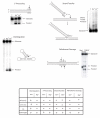Integrase and integration: biochemical activities of HIV-1 integrase
- PMID: 19091057
- PMCID: PMC2615046
- DOI: 10.1186/1742-4690-5-114
Integrase and integration: biochemical activities of HIV-1 integrase
Abstract
Integration of retroviral DNA is an obligatory step of retrovirus replication because proviral DNA is the template for productive infection. Integrase, a retroviral enzyme, catalyses integration. The process of integration can be divided into two sequential reactions. The first one, named 3'-processing, corresponds to a specific endonucleolytic reaction which prepares the viral DNA extremities to be competent for the subsequent covalent insertion, named strand transfer, into the host cell genome by a trans-esterification reaction. Recently, a novel specific activity of the full length integrase was reported, in vitro, by our group for two retroviral integrases (HIV-1 and PFV-1). This activity of internal cleavage occurs at a specific palindromic sequence mimicking the LTR-LTR junction described into the 2-LTR circles which are peculiar viral DNA forms found during viral infection. Moreover, recent studies demonstrated the existence of a weak palindromic consensus found at the integration sites. Taken together, these data underline the propensity of retroviral integrases for binding symmetrical sequences and give perspectives for targeting specific sequences used for gene therapy.
Figures


References
-
- Al Mawsawi LQ, Al Safi RI, Neamati N. Anti-infectives clinical progress of HIV-1 integrase inhibitors. Expert Opin Emerg Drugs. 2008;13:213–225. - PubMed
-
- Chow SA, Vincent KA, Ellison V, Brown PO. Reversal of integration and DNA splicing mediated by integrase of human immunodeficiency virus. Science. 1992;255:723–726. - PubMed
Publication types
MeSH terms
Substances
LinkOut - more resources
Full Text Sources
Other Literature Sources

